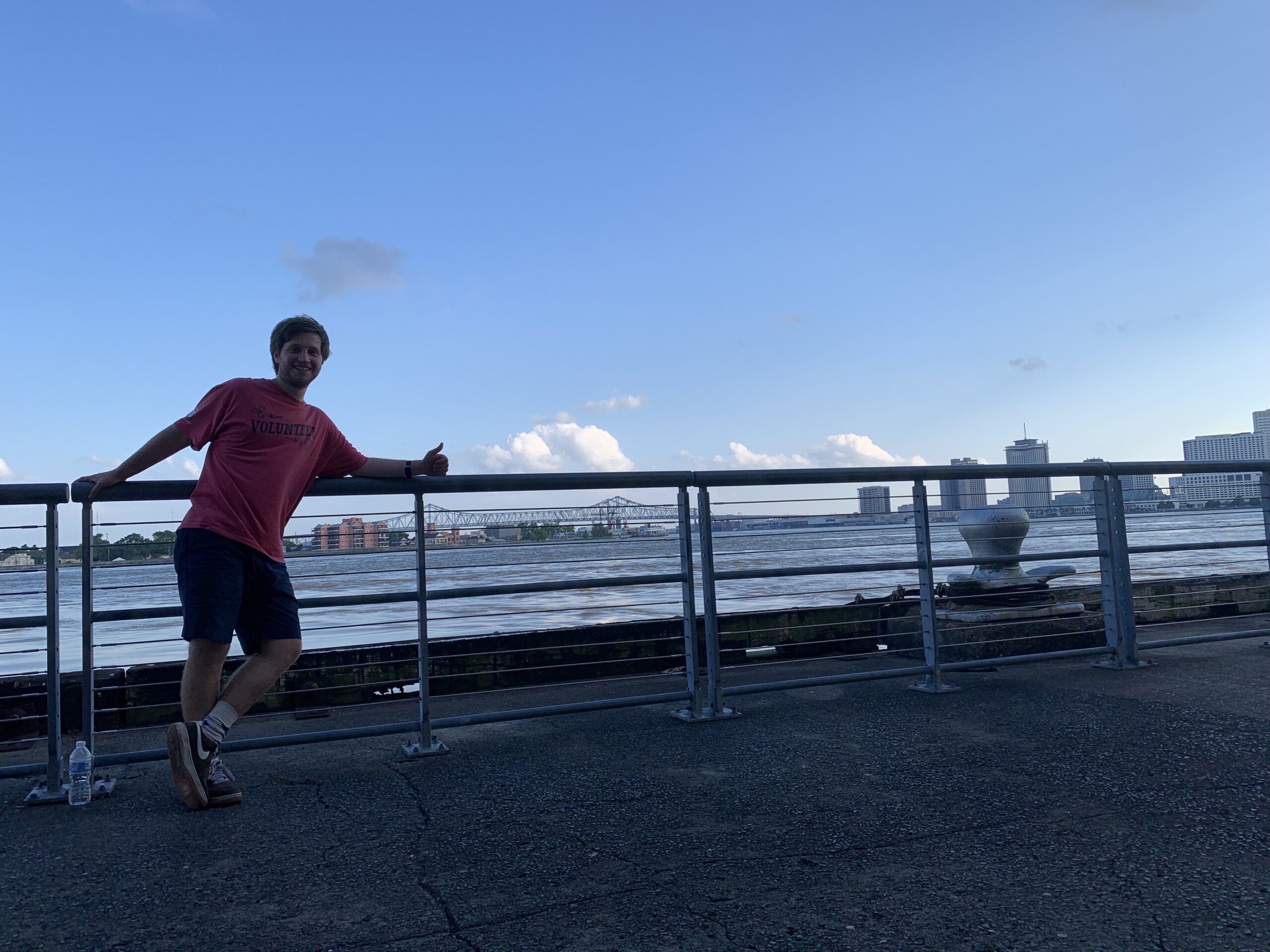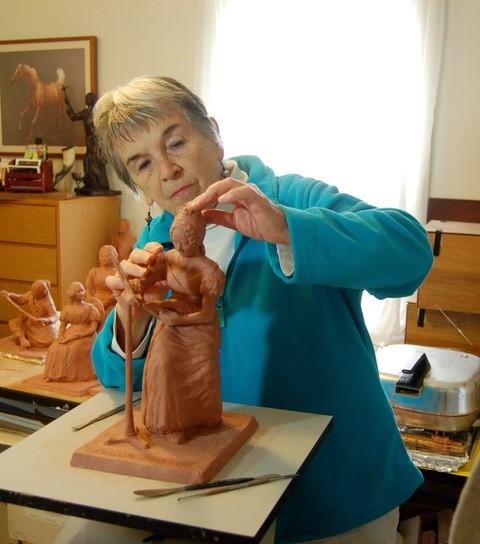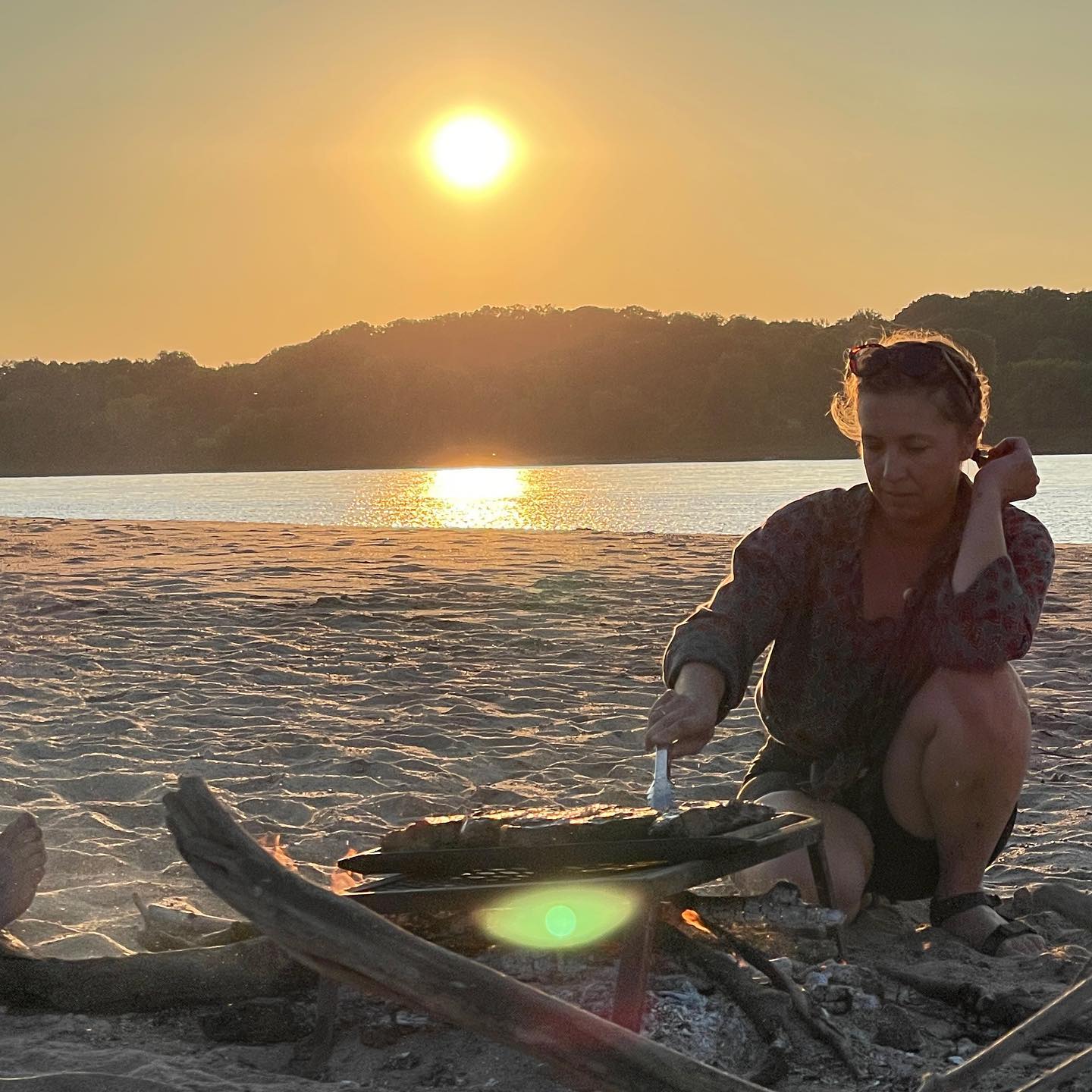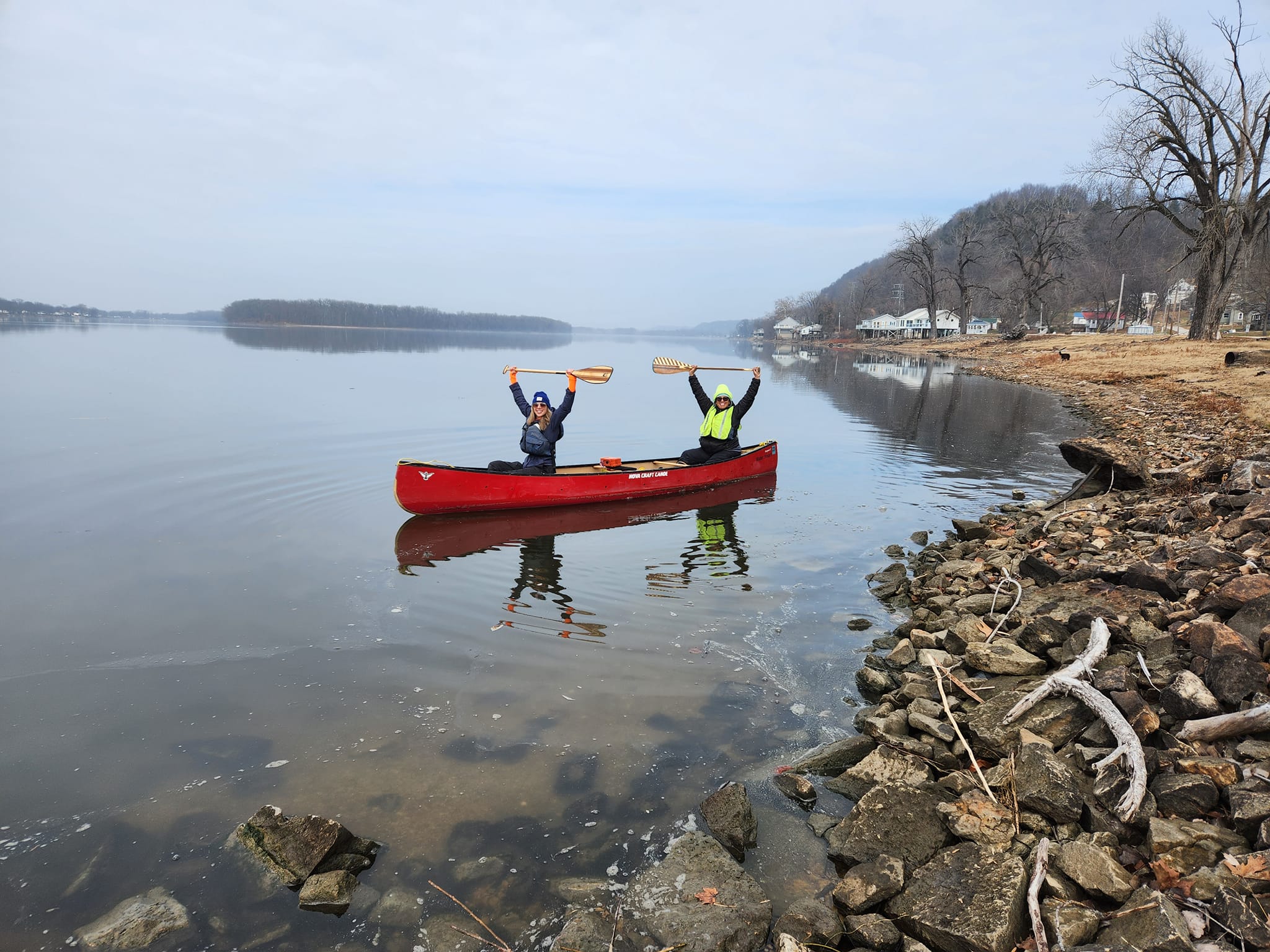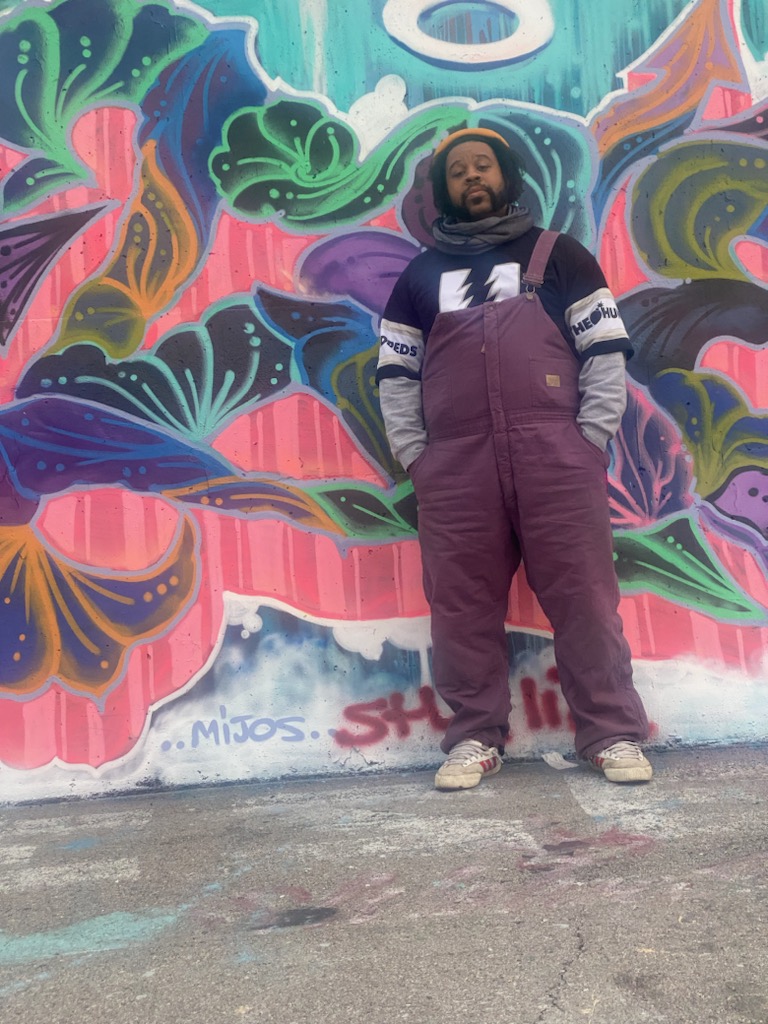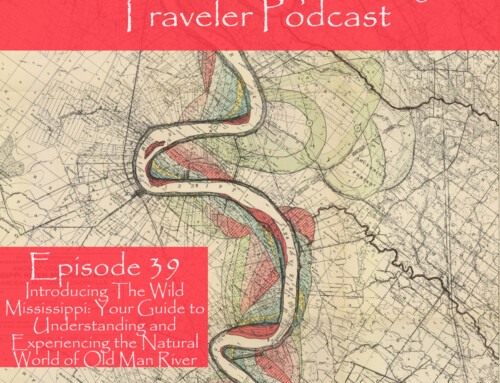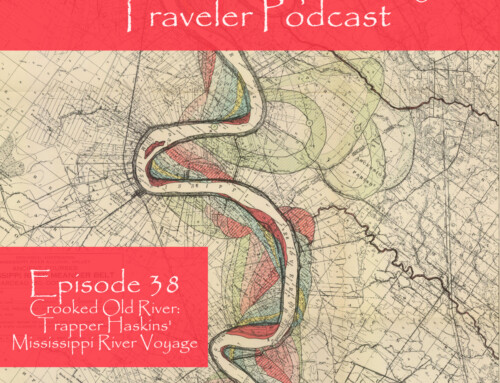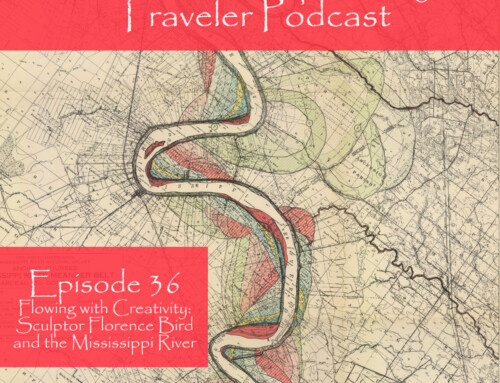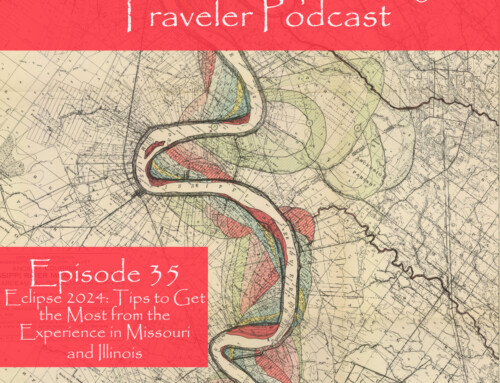What’s your Mississippi River like? Why do you keep coming back? For many people, the Mississippi means barges and Mark Twain, but the river is so much more than that. In this episode, we hear from five people who have a strong connection with the river that doesn’t involve barges or Mark Twain: a writer and poet, a sculptor, two long-distance paddlers, an owner of a guiding company, and an artist. They describe how they got interested in the Mississippi, their experiences of time along the river, and what time along the river means to them. Thanks to the Mississippi River Network for providing the funding and encouragement that made this project possible. In the Mississippi Minute, I have a few thoughts on the way we cover and think about the normal cycle of high water in spring.
Show Notes
Support the Show
If you are enjoying the podcast, please consider showing your support by making a one-time contribution or by supporting as a regular contributor through Patreon. Every dollar you contribute makes it possible for me to continue sharing stories about America’s Greatest River.
Don’t want to deal with Patreon? No worries. You can show some love by buying me a coffee (which I drink a lot of!). Just click on the link below.
Transcript
SUMMARY KEYWORDS
river, mississippi, mississippi river, water, people, barges, place, trip, fishing, louis, area, part, taught, fly, fish, flooding, stepfather, clips, jamaal, spring
SPEAKERS
Dean Klinkenberg, Jamaal Hodge, Florence Bird, Cory Maria Dack, Jorge Adabin, Fiona Fordyce, Sarah Lent
Jorge Adabin 00:00
Going out to the river was just always a place to calm down, and just kind of take it slow and take it easy
Dean Klinkenberg 00:27
Welcome to the Mississippi Valley Traveler Podcast. I’m Dean Klinkenberg. And I’ve been exploring the deep history and rich culture of the people in places along America’s greatest river, the Mississippi since 2007. Join me as I go deep into the characters and places along the river and occasionally wander into other stories from the Midwest and other rivers. Read the episode show notes and get more information on the Mississippi at MississippiValleyTraveler.com. Let’s get going.
Dean Klinkenberg 00:57
Welcome to Episode 18 of the Mississippi Valley Traveler Podcast. In this episode, I’m going to introduce you to a few people I met last year as part of a project I was working on with the Mississippi River Network to explore the many ways that we enjoy the Mississippi. This project was really just the beginning for me, a first step I hope as I collect stories about our relationship with the Mississippi, about what it means to us. For that project, I talked with 10 people who came from many different backgrounds and live all along the river’s length, which was one of my primary goals. In this episode, I’m going to highlight five of those people. I’ll offer a brief introduction for each person, but mostly I want to let them speak for themselves. The recording quality isn’t always great. Sorry about that. But sometimes we had to meet in public places a record in less than ideal circumstances. Still, I think it’s far more interesting to hear their stories from them directly, rather than to listen to me try to summarize their stories for them. Thanks to those of you who show some love through Patreon, including new supporters like Jude Duffell, your support keeps the show going. Go to patreon.com/DeanKlinkenberg If you’d like to join the community of Patreon supporters. And if that’s not your thing, you can show some love by buying me a coffee. I drink plenty of that. Go to my website, MississippiValleytraveler.com/podcast to find out how. And now on with the show.
Dean Klinkenberg 02:34
As I said last year, I had the great good fortune to talk to a bunch of people why the about why they spend time along the Mississippi, a project funded by the Mississippi River Network. One thing that really stood out to me: The reasons vary a lot and none of us knows exactly the same Mississippi River. I think that’s fantastic. The Mississippi is a big river and our love for it is just as long, deep and wide as the river itself. Our perceptions of the river just need to catch up to its realities. In some surveys for example, the image of the Mississippi that comes to mind first for most people is barges floating by. I sometimes get discouraged by that. As a people, we turned our backs on our big rivers over a century ago and the shipping industry stepped into the vacuum. Barges dominate so much of our image of the river because few other images get around. When the river got low last year and inconvenienced those barges, we heard about it endlessly from the news media, which created an impression that slowing down barges would create an economic disaster, which just isn’t true. Maybe I’ll get to that in another episode. Of course, when we think about the Mississippi it’s hard not to think of Mark Twain’s river of steamboats and epic raft trips. We sstill have those images in our imaginations when it comes to the Mississippi. The thing is, the river has changed dramatically since Twain’s days. We’ve changed the river dramatically. But while those images may dominate public perceptions of the Mississippi, especially among people who don’t live near at or visit very often, those of us who are blessed to spend time along the river consistently understand that there is much more to the Mississippi than barges and paddlewheelers of the past. And we find an incredible variety of ways to get meaning and enjoyment from time along the river. The river’s scenic beauty is generally a unifying force. Most of us appreciate that part of being along the river. We can all get behind that. It’s probably the main reason that a Facebook group that features photos to the river has more than 160,000 followers. But goodness, there are so many more reasons to appreciate the river. When I was thinking about this before I started the project, I came up with the following ways that I could think of that people enjoy the river: Fishing, paddling, hiking, taking pictures, birding, boating, swimming activities, that help us improve our mental health or provide a break or help calm us, art inspired by the river, painters, poets, etc. There’s music inspired by the river. There are people who work tirelessly to monitor the water quality in the Mississippi. There are people who work to restore habitats along the river. Those are just some of the reasons I thought of quickly. One of the original goals for this project was to show off the diversity of people who engage with the river. And I’m really pleased how this part of the project turned out. I interviewed folks from the length of the river. I managed to get four from the upper part of the river, two who live along the middle Mississippi, and two from the lower part of the river. And two more who I think kind of represent the the river as a whole. You’ll find interviews with men and women about the equal in numbers among this group, and I talked with people from a variety of racial and ethnic backgrounds. All of that reflects the variety of people who spend time and and appreciate the Mississippi every single day. Ultimately, though, this was about showing off the many ways we engage with the Mississippi and I think these profiles covered quite a spectrum. I’m gonna highlight just five of those people in this, in this segment of the podcast. And among them, you’re gonna hear people who write poetry inspired by the river, artists, people who enjoy fishing, people with the other connections to the river that inspires their art or their lives, who [the river] provides a place to calm and relax. So it’s an interesting group of people, and I’ve barely scratched the surface. So let’s get on to the first person.
Dean Klinkenberg 06:49
Native New Orleanian Jorge Abadin is a writer and student of literature. In the following clips from our conversation, he describes how he got hooked spending time along the river by going there basically to slow down and unplug, to relax. Then he mentions a couple of his favorite places in New Orleans, The fly at Audubon Park and Crescent Park. You’ll hear how the river has inspired his writing and a couple of short stories about unique aspects of life along the Mississippi River. If you want to hear one of his river-inspired poems, check out episode 13 of this podcast. And so here’s Jorge Abadin.
Jorge Adabin 07:28
On the Baton Rouge side not the like Port Allen side, they have a, it spells out Baton Rouge along like the concrete levee kind of thing. And when the river is low enough, I went out there one night at like, eight o’clock at night, just to kind of clear my head and just go sit out by you know, the water and watch the river and read a book or something. And this, these kids were out there, and they were like, just so excited. And they would, they ran up to the letters and they slid down because it’s really smooth compared to like the rock and they slid down to the, you know, the full length the levee and I was like, Whoa, like, what do y’all do. They’re like, Look, you just like, lean to the, you know, lean to the side, you just slide down. So you just, you know, you zoom down, and then you nearly fall into the water. And it’s like, just the most fun thing. So I’d always, like, take friends out there and do that. But yeah, Baton Rouge kind of during undergrad was just, you know, because LSU was just so you know, kind of an all over the place kind of school, you know, very, a lot of partying a lot of you know, social life going on. So and then also like I was in some pretty intense school. So going out to the river was just always a place to calm down. And, you know, and I was like, you know, I was an English major, and then English and Spanish and then studying literature, so like it was just a great place to disconnect from campus and just kind of take it slow and take it easy and you know, enjoy the water, you know, even though how, you know, beautiful or ugly it was given on any day. But always a really calming place.
Jorge Adabin 09:11
That spot at the end of The Fly, I don’t know if you found the exact spot. It’s like, you know, when you like drive through, there’s just like one little big plot of grass and like for everybody in high school and like, you know, early college that was like, whenever you came back in town, everybody was always kind of sitting there bringing out a chair like, bringing out some food from one of the restaurants close by and like it, like I guarantee there’s like 75% of people that were born and raised in New Orleans will say the same thing about The Fly, like you just go out there and watch the tugs. And you know, you watch the barges come by and it’s like, just really… and then that’s sometimes, that’s where the, when the river gets really low, there’ll be those little sandbars right there too. And it’s like, you’ll see people fishing, you know, like, you’ll see just like some people really, you know, getting into the water like really enjoying. It’s just, I don’t know, it’s just really fun to see like, how, you know, it can kind of go up and down. And you know, people can really enjoy different ways like that.
Jorge Adabin 10:08
[About Crescent Park:] There’s one little bench like right outside of the pavilion that I’ll always just sit there. And I used to bring, like, I studied a little while in Argentina, I bring my mate out there, you know, I would bring my little, bring a book or something, you know, something to write with. Yeah, that’s definitely one of the best spots. And then it’s, I completely agree, just like the ruins, you know, like, the little like, the train tracks, you know, like, it’s, it’s Crescent Park is just fantastic… I know they keep up the other half of it so nicely, you know, they really care about that part. But, yeah, it is a nice little description of New Orleans of like, ruin and beauty, you know, coinciding together on the river.
Jorge Adabin 10:54
So the river, just for me has always meant, like, just really meant opposites. You know, it’s like, it may mean so many things that it almost, it means everything, and it means nothing, you know? It’s like, it’s life, its death. It’s beautiful, it’s ugly. It’s clear, it’s muddy. It’s, you know, like, it’s rough and calm at the same time. So it just kind of, at that point, just, again, like I said, means everything, and it means nothing. So it’s like, whenever I was in a kind of a rough space, like, remembering just that, that no matter what, how you look at the river, it’s the river, you know, like, it’s always flowing, it’s always moving. It’s, it’s at one point, the, you know, the, you know, the lifeblood of the US, you know, and at one point, it’s, you know, just the lazy river, you know? It’s just like, so for me, like, whenever I can kind of latch in on that, and, you know, remember that, it just really helps me, right? And, you know, I think if you, you know, in my writing kind of see, like, the flow of the river is just pretty much all there is, you know, like, kind of getting into your, you know, into your inner core. And, you know, just like remembering that just always, it’s really inspiring for me.
Jorge Adabin 12:07
In my PhD, like, the big thing that I really liked to study was, I got really into spirituals and gospel music of New Orleans, mostly, like the standards. And just what would really really inspire me was like, those, like, the standards of like, specifically that you, I think of as I’ll Fly Away and Down by the Riverside, and like, those songs, again, have been, like, played for 200 years now, in one form or another, you know? And like, what they’ve meant over time changes, but the words are the same, like, specifically like, and you see it in my in my writing as in I’ll Fly Away to God’s celestial shore. And it’s like, that image is just, and when I think about it, I think about Algiers Point, you know, like, sitting out there on the grass and Algiers Point on a sunny day, like, a little windy on the river, a barge passes by, and it’s like, you know, you’re just content, you know, it’s like, this is God’s celestial shore, you know? You know, whatever religious beliefs you ascribe to, like, it’s like one of those moments where you’re just like, This is it, you know? And then in Down by the Riverside, and we’re going to lay down my burdens down by the riverside, you know, I ain’t gonna study war no more, and it’s just, and what that’s meant for, you know? The Dukes of Dixieland when they’re on the riverboat, you know, like playing, you know, playing Down by the Riverside, it means something different than, than it did when, you know, like, during slavery, and you’re seeing, I mean, think about how powerful that is, like, I’ll fly away to God celestial shore. As somebody that’s enslaved, like, that’s just the river, just means something so powerful, you know, in those senses, so I really like to see those changes and just that how the music and you know, I guess that’s all poetry, you know, in a way too, but yeah, those handful of gospel songs have just been completely you know, our, you know, subliminal, sublime, you know, awe inspiring, but it all goes back to the river.
Jorge Adabin 14:06
Yeah. Every year in December when everybody comes in for you know, winter, we have two birthdays that line up on one of my friend’s birthdays on the 26th and then ones on the 27th so we always have this big party of like, you know, that blends into the other birthday and it at first it was like we tried to make these like just really crazy fun plans like go to a concert and do this or that and go to karaoke. I don’t know, whatever but it just it’s kind of consistently turned into we take the ferry across the river and go to Old Point Bar, go to, go to the other the pizza place right there, Tavs. We go, you know, we kind of just bounce around Algiers Point and then we take the ferry back and like the whole night is kind of centered around being on the ferry with like, 15 or 20 of your friends and like, you know, just the most fun. Yeah, and then you go to Algiers Point, you know, Point Bar, and you’re, you know, you pack the place, play some pool, play some darts, and then come back. And then you got, you know, all the music in New Orleans too. But yeah, we pretty much center it around everybody meeting at the, you know, at the ferry station. And it’s, and then again, you know, people take that for work people take it for, you know, to get back home. So it’s like, you just have these people that are there every day. And then I don’t know, people kind of forget how, you know, cool it is that, you know, we can just take this little public transportation that is, you know, on the river
Jorge Adabin 15:30
But yeah, and then that area is also just one of the coolest thing. I mean, that’s probably the most indicative thing, or the most descriptive thing of Louisiana. And the river in general is like, when I went to the end of the, you know, to the end of the river, it’s like, we had to park like half a mile away. And then we had to wade through, you know, flooded waters past the oil refinery, you know, like, past the old, like the wrecked fishing camps to get to the actual end, because, you know, that’s how, that’s how Louisiana, that’s the relationship between Louisiana and the river. It’s, you know, whatever the river wants, the river gets, you know, so, you know, we didn’t know if a gator was gonna, like, swim up to us. And, you know, give us a high five on the way over there. But you know, we had to get to the end.
Dean Klinkenberg 16:21
Hey, Dean Klinkenberg here, interrupting myself. Just wanted to remind you that if you’d like to know more about the Mississippi River, check out my books. I write the Mississippi Valley Traveler guidebooks for people who want to get to know the river better. I also write the Frank Dodge mystery series set in places along the Mississippi. Read those books to find out how many different ways my protagonist Frank Dodge can get into trouble. My newest book, Mississippi River Mayhem details some of the disasters and tragedies that happened along Old Man River. Find any of them wherever books are sold.
Dean Klinkenberg 16:56
So next up, I’ve got a short clip from sculptor Florence Bird. Florence lives in Prairie du Chien, Wisconsin, near the confluence of the Wisconsin and Mississippi Rivers, in one of the oldest communities, one of the oldest continuously inhabited areas along the upper Mississippi, especially. And in this clip, she’s going to talk a little bit about the moment when she had the inspiration to create more than two dozen sculptures to represent the people who helped shaped that area. It’s a little funny that during my conversation with Florence Bird, my parrot had to contribute some, so you’ll hear my parrot’s squawk a little bit in the background of this interview. So here without further ado, is Florence Bird.
Florence Bird 17:44
When I first got to Prairie du Chien, and I was standing by the Mississippi River, I said, “This is the river of Mark Twain and steamboats.” And so it was a magical place for me and that’s that’s when I just wondered who else stood here and, you know, the confluence of the rivers. Just actually, I think of it as a confluence of cultures here. And historically, because it’s really the only flat place along the Mississippi where you’d have a community like this and and it’s, it’s just you know, full of history and prehistory and mounds and everything. So it has no end of fascinating subjects. And then, then I see an article in the newspaper that there were a pot shard found here from Cahokia. And then somebody found mastodon bones here and then, and then somebody reminded me that Father Mazzucchelli had the Catholic Church built here. And then it just went on and on like this. And I’ve got files and files of information on each of each of the people that I want in the sculpture park.
Dean Klinkenberg 19:23
In December, I had a chance to talk with Cory Maria Dack and Sarah Lent as they stopped in St. Louis for a little rest and a warm up. They were long distance paddlers who got started a little later in the season than many do, and they were about to paddle into the teeth of winter. And during this clip, you’ll hear a little bit about their inspiration for why they wanted to do this trip and then some of their fears about paddling so late into the season. Cory had previously worked on the river with Augustana College’s River Semester, where she served as kind of a faculty member and guide for a group of students who explored the upper part of the river. And Sarah had joined her just 10 days before we met to replace the person who had originally started the trip with Cory. You know, they were both had kind of their own agendas for this trip, their own goals. And at the very least, it was partly to break the mold of who we think of when we think of long distance paddlers, to be role models for women, for people of color, to create a new model for what it means to be a long distance paddle on the Mississippi. They did finish their trip, they got, they had to take some breaks when the weather got especially bad, and especially cold in the wintertime. But they got right back on when they had the opportunity. And they, they finished the paddle into the Gulf of Mexico in early spring. So here are a few clips from Corey Maria Dack and Sarah Lent.
Cory Maria Dack 21:01
And on that trip [with the River Semester] over the course of 100 days, we did Minneapolis to Cairo. And I found myself kind of thinking about the rest of the river north of the Twin Cities and south of Cairo. And it just kind of felt right as time went by. I kind of thought who might go with me when I, when I do this. It was like a very natural, slow burn, not some crazy desire I’ve had my whole life. It was an idea that kind of took seed. And I sort of nurtured it, as I did other things. And the idea just kind of kept growing and kept growing and kept growing. So I remember thinking, as long as I’m not winter camping the whole time. Yeah. Well, joke’s on me, because here we are. But I do think that as hard as it has been, that there have been some times that it has been really, really hard, but the whole time has not always been as terrible as I feared, my greatest fears. Today, we started to get sprayed with a garden hose and it slowly, slowly turned up to fire. By the time we got to firehouse status, though we were, we’d like built upon skills to…
Sarah Lent 22:21
like receive the good with everything we’re getting in.
Cory Maria Dack 22:27
The Mississippi in her infancy is just, she’s so pristine, and she’s so gentle. She’s so beautiful. She’s fragile and powerful at the same time. And you want to protect her, but also she’ll like kick your ass at same time. And she just winds through, especially when we left at the end of August, the water was already pretty low, she winds through this labyrinth of wild rice, and there’s rapids that you run, through wooded forest. And I think like the wild rice beds, like we will never see that again. And I had known even just on River Semester Minneapolis to Cairo, and I know further down like what we saw in those first 55 miles. We’ll never see again. So I felt so grateful.
Sarah Lent 23:18
I think what I’ve learned so much about it is, like how much love there is for this river, as well. I think I’ve really taken things, I, I would say I’ve been spoiled in my first seven days, where I’ve hopped on this trip. And even though it’s December, we’ve had nice weather. We’ve had, you know, almost no wind just like the perfect weather you could ask her for this time of year. Like so many days, the river has been like flat and just like perfect paddling, but what we’ve had each night though, and each day is just community along the river, is getting to meet different river angels and people that have taken us in and share their stories of why they’re river angels or why they love the river, how they interact with the river. And just, yeah, each night meeting more and more people who love the Mississippi River who love the town they live in along the river and can share that with you. And having just a guide, or like learning someone else’s connection to it and making me think back on my own connection and how I’ve seen the river, whether it’s in Minneapolis or like, you know… I’ve taken atrip to Lake Itasca myself once before and you know, seeing her when she’s just you know, you can walk across it, but never imagining you know, it’s always been… I think if you grew up on teh Mississippi, you know, you get in your head, like oh, it would be cool to see the whole river. You learn that it’s an important body of water to like this country and to people along it, but then just getting, in this trip seeing how important it is individual people and why they love it. So for me just seeing how much love there is for this river.
Cory Maria Dack 24:44
Because one of the missions and messages I bring is, I want people of color to feel safe on the water, to feel welcome on the river, and I want them to see themselves in me.
Dean Klinkenberg 24:55
The next one we’ll listen to is Fiona Fordyce, who is a co-owner of Big Muddy Adventures in St. Louis. It’s the only canoe outfitter in the area. They take 1000s of people out on the Mississippi in canoes throughout the season, and one of the things they’re known for is the quality of the meals they serve during their expeditions. Fiona is responsible for that. She plans the menus and cooks much of the food. And her culinary skills were featured in a Feast Magazine article last year, which was was really nice to see. Well deserved praise. Fiona also grew up on the Missouri River. So in the clips that I’m about to play, you’ll hear a little bit about what she remembers from her childhood years growing up along the Missouri and then some of what she’s seen people experience when they get out of the Mississippi and some of the surprises that that they experience. So here’s Fiona Fordyce.
Fiona Fordyce 25:55
I grew up right on the Missouri, so I’ve always been like, since I was a little kid, “We’re paddling on the river. Oh, we were tossed in the river.” Babies. Yeah. Yeah, just take the inner tubes down to Pelican Island, go like arrowhead hunting and then continue on to Sioux Passage. So, it was yeah, it was really fun and never didn’t seem scary or dangerous at all. Yeah, I mean, you know, everybody thinks of the river, is just completely polluted and toxic, and, you know, something gross, but I think that Big Muddy in the last few years, it’s done a great job of really changing people’s perspective about that. I think the sandbars are what impress people mostly like, oh my gosh, this is like a beach. And you know, and then one of us will hop in the water and everybody thinks like, Oh, my God, I had no idea you could, you know, swim, hang out on the beach. And so yeah, probably, probably the swimming is what surprises most people. Yeah, and that it’s pleasant, and it’s warm, and it’s not gross, and toxic and smelly. And right. This is like Caribbean sand here in the middle of St. Louis. And yeah, nobody has any idea that we have like nature in St. Louis. So, so cool in the city. Yeah. So no, that’s really neat.
Fiona Fordyce 27:25
For me, it’s more fun. Like, yeah, I like going on the river on my own. But it’s even more fun to show people this thing that they didn’t know is there. And it’s like, that’s, I mean, aside from the repeat customers, everybody, everybody leaves saying like, “Oh, my God, I had no idea this was here.” And one of my big goal for Big Muddy this year is to do more expedition trips, and to market them to people who aren’t from St. Louis. So to get people to come to this area for just these trips. We do this trip called the French Quarter Expedition every year, which is from the arch to St. Genevieve. And every year, every year before this one, it was always a real ragtag group of you know, two or three people would sign up and they’re friends of ours anyway. But this year, for the first time, the trip sold out and I think there were four different people who flew from the coasts to St. Louis, just to do this trip. And I thought that was so cool that yeah, that people would, yeah, fly to St. Louis for a trip. And I think that would be such a good thing for the city and for the river. And for Yeah, to have, you know, coastal people recognizing the Mississippi as something cool.
Fiona Fordyce 28:55
When I was working as a tour guide in Alaska, I met this Spanish guy, Diego, and he owns a tour company in Spain, where he takes, he organizes, you know, groups of Spanish people and brings them on, like, adventure trips all over the world. So I talked him into, I was like, hey, you know, what’s actually really cool? You know, everybody in Spain has, you know, been to New York or LA, but I was like, the middle of the country, like has a lot of cool stuff, too. And so I organized this Mississippi River trip that they all flew in Chicago, and we went we just in a van went to St. Louis, St. Louis, Memphis, Natchez, Louisiana, and I kind of sold it to them as like this, you know, cultural trip and we like ate a bunch of barbecue and listened to a bunch of blues music. But they all like really loved it and they felt like they had discovered this like, you know, because all of their friends again had been to the you know, the more popular tourist places but they but they are kind of like discovering this part of America. And turns out one of the people who was on this trip was, uh, one of the lead journalists for this like big newspaper in Madrid, and wrote this whole article about, like, wrote this whole article about like, middle America and the Mississippi River and like the culture of the river. And I was like, wow, like, that’s so cool. Like, they were also impressed by that trip.
Fiona Fordyce 30:28
The Amazon is a huge attraction, like, people like to fly to South America to see the Amazon, like fly to Europe to see the Danube and like, it’s, it’s kind of nice to see finally, like… the Mississippi competes with those rivers for sure, easily. So it is sort of weird that it’s just been like, mis-marketed so terribly. I mean, especially in St. Louis. Like I just, I just like that we have this really unique outdoor rec opportunity here. So yeah, it’s just like so close to the city, you can feel like you’re far away in nature. And I just think that’s so yeah, it’s so neat. And I mean, just the scale of them is so impressive, like it’s they’re huge rivers.
Dean Klinkenberg 31:22
River folks are happy, eager even to share their stories about what they love about the Mississippi River. But sometimes it’s not always obvious who has a story to share. I was hanging out at my favorite coffee shop a while back and talking with another regular, Jamaal, about this project. I mentioned that I’d been talking to people about the ways they engage with the Mississippi and had been amazed at the variety of stories I had heard. He smiled, got quiet for a moment, then he shared a story from his own childhood about going to the river. And that’s how he ended up being one of the featured people in this project. Just a coffee shop contact. His stepfather used to take him fishing on the St. Louis riverfront just downriver of the poplar Street Bridge. Jamaal was about seven years old the first time they went, which kind of began as a way to get to know each other better. But Jamaal’s memory of those experiences went far beyond bonding with his stepfather and learning how to hook and fillet a fish. The St. Louis riverfront is lined with a tall concrete wall to keep high water out of the city’s neighborhoods. In the area where Jamaal and his stepfather and brother finished, the wall had been covered with graffiti, not by rogue taggers, but by artists invited to cover it as part of the city’s annual festival called Paint Louis. When Jamaal first saw those works of art, he was astonished. He’d never seen anything like those paintings before. He credits those trips to the Mississippi River, those moments of wonder wandering in front of the art on that wall with catalyzing his own interest in art and a career as a creative person. He’s a musician today, with one of his career highlights being getting to perform in Carnegie Hall as part of a choir. Today, he’s working with a music collective called Kinfolk. In the following clips, he talks about those childhood memories of time along the Mississippi River and how it inspired him and his interest in art. Here’s Jamaal Hodge.
Jamaal Hodge 33:17
He took us that we get our fishing, like our fishing equipment. We got our poles, he taught us how to like actually, like put our lines in there. Like he taught us how to find how to find worms, like bait. Like he would go, we went to, he took us to the Mississippi and I’m like, What is this? Never, never been, never been at this point. He taught us how to, he taught us how to scale the fish, he taught us how to get the bone out of it. He taught, he actually taught us how to fillet ’em, to. That was my first time like working with a knife as a child. is like, I had a little pocket knife. He was like alright, this is how you do it. I hated I hated the boning and descaling fish. Worst thing ever. I was like, Nah, you do that. But it taught me, it taught me how to like, properly cut a fish. Could I still do it? I’m out of practice, but I probably could. I think it’s kind of like riding a bike. I think, I think if I like got back to it, yeah, I probably could.
Jamaal Hodge 34:13
He eventually taught us a trick of catching the fish. He would, he would tell us to look at the water. Watch the water. You’ll see when they come up. You’ll see, you’ll see them pop up and then all of a sudden, you’ll see, you’ll see the ring of water, the ripple, and he’s like, they typically are in the same area doing, they’re looking for food. And then they come up, if there’s food on top of the water, they come up. Aim for that. Cast into that spot. Just be patient. Like be patient and watch. If you just if you just pay enough attention, you can see. Once I started doing that, I started catching fish more often.
Jamaal Hodge 34:55
But yeah. A lot of a lot of lessons learned fishing. Fishing, fishing will teach you patience, for sure. It was the most peaceful I ever saw that man. Ever. Like, I’m not saying he was not a peaceful soul; he was a pastor. So I’m not saying he wasn’t a peaceful soul, but he was at ease. Yeah. When he was fishing he was at ease. You want to learn, you want to learn something, you want to learn someone, there’s there’s two ways to learn someone: building Ikea furniture with them, and going fishing with them. Two best ways to learn a person. He, that… learning, being with him, not only did it teach me patience, but it also taught me to be observant. When it when it came to being at the Mississippi River. It, it basically just taught me to observe my surroundings. And be, and be present, ’cause when you’re fishing, you have to be present. Like you’re there, you just, you just, you and the river. I think that was the most, that was the most time that we spent together, outside of like being at home, was either fishing or hunting, but mostly fishing, I think I fished with more than I hunted with him. And I learned who he was as a human. I got to see him as a human, not just my stepfather. And that was, that was something beautiful that he like gave to us. I think we, for that whole year, we went like maybe like once every like other week to go fishing the Mississippi. And those are like some of the most prominently, like memorable moments in my childhood.
Jamaal Hodge 36:32
And you see that you just, you go you drive down there. And you see this large wall of just graffiti and art. And this is my first interaction with graffiti, like I’ve I loved art at this point. As a kid, I was already getting, falling into music. I was falling into painting or falling into drawing like, I loved art at this point. And then he, he takes us here and you see this large, amazing wall full of just dope and beautiful art. And I’m in awe. I’m captivated at this point. It just goes on and goes on and off forever. That’s like the first thing that I remember going to the Mississippi to this day, to this day. That is the main reason I started doing art. Like I’m not, I do not consider myself an artist, but I do consider myself creative. That is one of those key starts of me being, becoming creative. And wanting to and wanting to learn something and being passionate about learning something it triggered for me. I don’t think I was passionate about learning anything at that point like I was a child obviously, right? But that is the key point that made me want to become a creative. To this day, I’m still creative, a musician. I make music. But my art drove me to becoming a musician
Jamaal Hodge 37:57
In that, at that point, I realized that there was just there’s so much that could be connected in the world, and realizing that at a young age opened my mind. And that would have never happened if I would not have went fishing at the Mississippi River.
Dean Klinkenberg 38:12
Well, those are just a few of the voices of people who told me about their connection to the Mississippi. As I roll out the rest of the profiles via social media. in the next couple of weeks, you’ll hear from a few more people including a river angel, the man who started a Facebook group to show off pictures of the Mississippi, a young man who fishes along the Mississippi partly for the challenge but also partly to calm and level out, a conservationist who specializes in birds who is also a top notch musician, and a Native American woman who founded a group to protect and honor our precious waters and has walked thousands of miles to do so. The Mississippi doesn’t belong to any one of us or to any one industry. It’s our river, all of ours. And these stories help to shine more light on all the ways that the river matters to us. I’d love to hear from you. Why do you enjoy spending time along the Mississippi? What’s your connection to the Great River? Drop me a note at MississippiValleyTraveler.com.
Dean Klinkenberg 39:24
And now it’s time for the Mississippi Minute. The news media has been feeding its voracious appetite for stories about tragedy and drama with a steady stream of reports about flooding along the upper Mississippi this spring. I don’t want to downplay the hardships that high water can create for some people, but I have to admit that I feel more cynical this time around about the media coverage. In the last three or four decades, communities along the upper Mississippi have made a lot of effort to reduce the risk of monetary losses from spring flooding, usually by moving housing and development out of the floodplain. This spring we’ve seen higher water than usual in some places, which is due mostly to a deep snowpack that melted relatively quickly. This created a surge in water flowing into streams that, barring consistently heavy rains, will fall almost as quickly as they rose. This is a normal process. Still, much of the land under water this spring consists of public parks, places that were set aside from development to accommodate those predictable annual increases in flooding. One dramatic picture I saw making the rounds in the media was a stone building next to the river that was surrounded by water. I know that building. It’s a bathhouse on La Crosse’s Pettibone Island that gets wet often, and will clean up pretty quickly with a hose and a mop after the water recedes. Not exactly the face of tragedy no matter how dramatic the pictures look. There are some houses facing threats, but they are mostly in places that see how high water frequently in the spring. And in the past 15 years, I can think of several times that the baseball stadium at Davenport has been surrounded by water. And it’s made national news every time because it’s a compelling image. You’ll see plenty of pictures of that baseball park surrounded by water again this year. Now the people who live in these areas that flood periodically, are accustomed to dealing with these fluctuations in the river. The owners of the baseball stadium have their own process for dealing with high water. None of this is a tragedy. This is normal life along a river, especially a big river. And when we crowd the river by building homes and businesses in areas that have flooded for millions of years, the costs and inconveniences of dealing with high water are ones we’ve created for ourselves. Spring flooding is as natural variation, as much a part of the cycle of life, as leaves changing color in the fall and coming back in the spring. Let’s get over the idea that these natural processes are disasters.
Dean Klinkenberg 41:58
Thanks for listening. I offer the podcast for free but when you support the show with a few bucks through Patreon, you help keep the program going. Just go to Patreon.com/DeanKlinkenberg. I’d be grateful if you’d leave a review on iTunes or your preferred podcast app. Each review makes a difference and helps other fans of the Mississippi River and the Midwest find this show. The Mississippi Valley Traveler podcast is written and produced by me, Dean Klinkenberg. Original Music by Noah Fence. See you next time.
